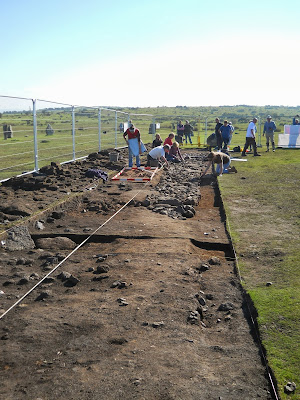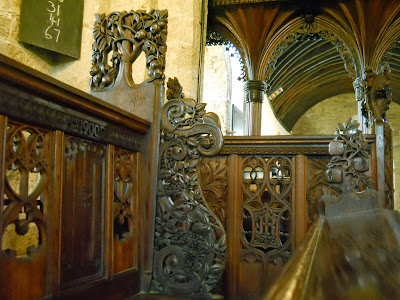Perhaps the oldest structure was Trethevy quoit on Bodmin Moor. This is a dolmen, a chamber made from huge stones thought to date to the end of the Neolithic (Late Stone Age), about 5,500 years ago. There are a few in Britain, some having shown evidence of burials within them but they may have also had other purposes such as territorial markers. No one really knows with certainty the original purpose of these chambers, but they are also found as far away as Korea and India.
On the same side of the moor one can find the Hurlers, a row of three (or possibly four) stone circles and outlying stones, which may date to the Bronze Age or may be older. They lie in a SSW-NNE alignment.
We were very lucky to visit them whilst an excavation was taking place to uncover a 'pavement' of white quartz stones, which appears to link two of the circles and runs in the same orientation. The quartz structure has only been uncovered in modern times once before, in 1938, and will be covered over again once the project is completed. The local community was assisting with the dig, which was tied in to a study of the astronomical orientations of the site that is being conducted by the Roseland Observatory. It's interesting to think what the Hurlers must once have looked like. The stones in the circles show evidence of having been hammered to shape and the pavement of quartz must have glowed and twinkled in certain light conditions.
The castle ruins that can be seen today are comparatively recent, having been built in the 13th century by Richard, Earl of Cornwall. There is archaeological evidence for much older use of the headland though, going back to Romano-British times. However, no traces of an actual settlement on the site then have so far been found, although evidence for early trade with Mediterranean societies has been discovered here.
After a walk of about two hours along the beautiful coastline, past Bossiney Haven...
... one arrives at Rocky Valley.
The river is followed upstream for a while...
... to a ruined watermill.
On a rockface behind the mill ruins are carved two of the most intriguing carvings that I know of. They are surrounded by offerings tied to trees and scratched into stones, which have then been lodged into cracks in the rock. A plaque nearby notes that they are 'probably of the early Bronze Age (1800 - 1400 BC)'. In truth, they are almost impossible to date. They are two labyrinths.
This design is a unicursal maze. There are no dead-ends or branches, just a single path travelling into the centre then out again. The design is ancient, a square version having been found on a clay tablet from the Mycenaean palace at Pylos, which was destroyed by fire around 1200 BC.
Stone carvings that may be more recent, although still very old, can be seen back on Bodmin moor. One is the Longstone, or Long Tom; a cross carved in granite. Some people believe that this is an example of the Christianisation of an ancient menhir (standing stone). Rather than destroy the pagan relic a cross might have been carved onto it, perhaps because it was too useful as a wayside marker on the inhospitable moor to be taken down or because of some other particular importance to local people.
Another nearby monument of carved granite is certainly Christian, albeit still very old. It is called King Doniert's Stone but is actually two granite bases for crosses, which have interesting Celtic knotwork and an inscription carved into them.
The inscription says in Latin 'Doniert Progavit Pro Anima', which translates as 'Doniert ordered (this cross) for (the good of) his soul'. Doniert is thought to be King Durngarth of Cornwall, who drowned in the river Fowey around AD 875.
The stones are decorated with carvings of late 9th century style and sockets carved into the tops of the stones may once have held separate parts of the monument; perhaps wooden cross heads?
An underground passage cut into the hard granite begins about 8 metres (26.25 feet) from the stones and terminates below them in a cross-shaped chamber. The relationship between the stones and the passageway and chamber is unknown.
As with most, if not all, of the ancient carvings and man-made structures in the county, this Cornish monument leaves the visitor considering questions to which we will probably never know the answers.





















































